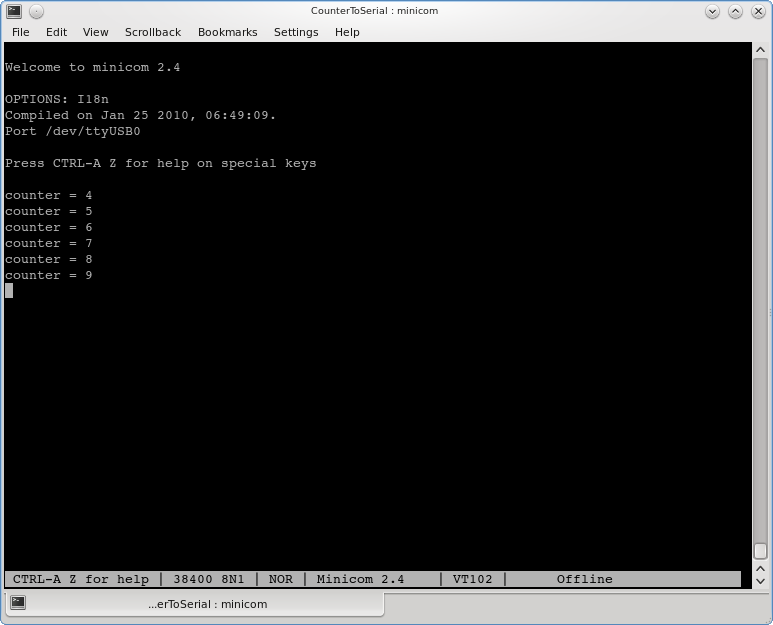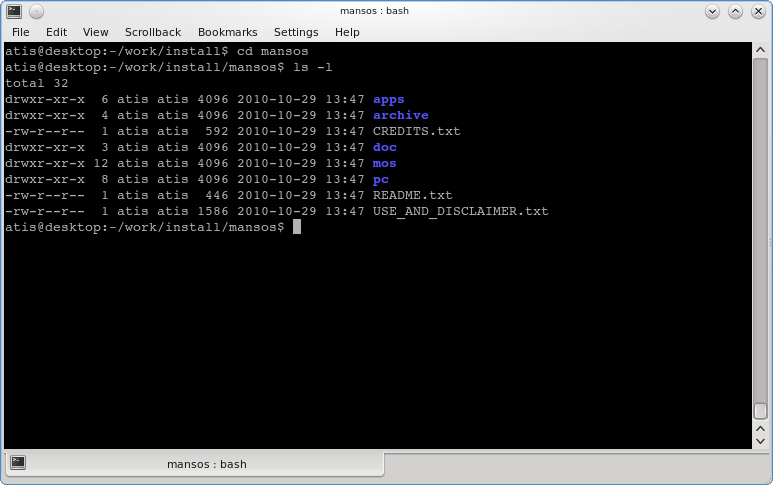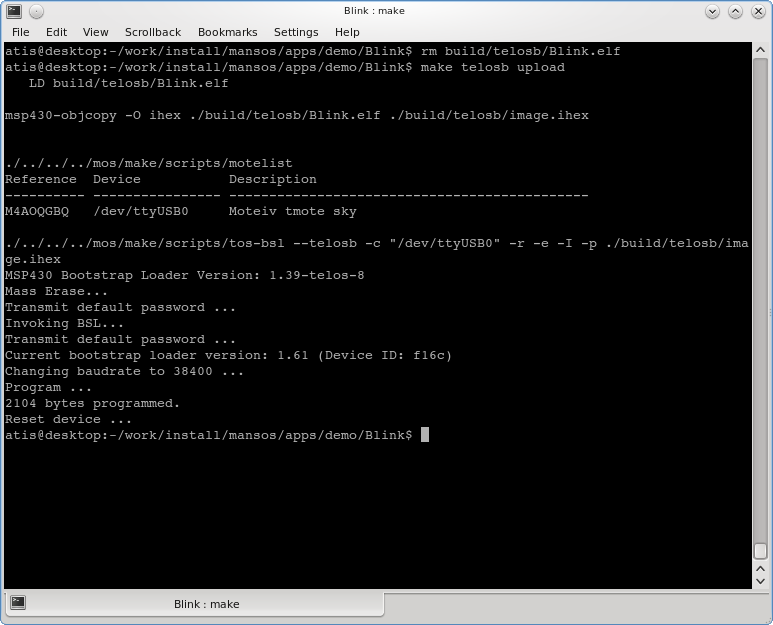Installing MansOS
When installing MansOS development environment you need to decide two things:
- What is the development host - where the application is developed and compiled. MansOS supports Linux, Windows, and MacOS operating systems. The best version is usually available for Linux first.
- What is the target platform(s) - on which the application will be running. At least the main micro controller should be known. MansOS supports several popular target controller families, e.g.: TI msp430, 8-bit Atmega controllers. One can also compile the application for the current PC host, for example, for simulation and debugging purposes.
Step 1: Prerequisites
In general, the following programs are needed:
- Compiler and binutils
- For example, msp430-gcc for TelosB and msp430 platforms or avr-gcc for Atmega platform
- GNU make
- Python
If you already have them, you can skip this section.
Linux (e.g. Ubuntu)
MSP430
Often MSP430 GCC toolchain is available as package in the OS repository.
- To install for Ubuntu (12.04 and higher) one or both lines should suffice:
sudo apt-get install make gcc-msp430 sudo apt-get install msp430-libc binutils-msp430 python-wxtools python-serial python-ply
Atmega controllers and Arduino
Atmega platform support includes controllers such as ATMega328P MCU, which is a part of Arduino Duemillanove.
This platform requires AVR-GCC toolchain. In Ubuntu you can get one as follows:
sudo apt-get install gcc-avr avr-libc binutils-avr avrdude
Warning: older avr-gcc and avr-libc version (prior 4.3.4) do not support ATMega328P micro controller, which is used in MansOS. If your distribution has an older avr-gcc, you can compile AVR toolchain by hand.
Warning: If you have TinyOS installed from TinyOS repository, you must uninstall TinyOS AVR packages which do conflict with the newest versions provided by official Ubuntu repository:
sudo apt-get remove avr-binutils-tinyos avr-gcc-tinyos avr-libc-tinyos
Read here for more about the support of the Atmega controllers in Mansos and the required tools.
Nordic Semiconductor (nRF)
nRF platform for Nordic Semiconductors controllers with RF+MCU chips such as nrf24le1 may need SDCC compiler. Here are the SDCC installation instructions.
MacOS X
Developer tools must be installed to support compilation environment. It can be found either on MacOS X installation DVD, or on Apple web page.
TelosB / MSP430 platform
MSP430 toolchain is required. The easiest way is to install MCP430 GCC v4, which has a pretty straightforward installation script prepared. Download it from http://mspgcc4.sourceforge.net/ .
Alternatively there is a pre-built Contiki OS package for MacOS X, provided by the Contiki Team at SICS. It includes MSP430 toolchain (version 3.3, works for TelosB) as part of Contiki OS.
Arduino / ATMega platform
Arduino platform requires AVR-GCC toolchain. Although it is included in TinyOS, the version included is too old and does not support ATMega328P MCU, which is a part of Arduino Duemillanove. Therefore there are two options. Please choose just one of them (not both at a time!):
- a) Download a ready-to-use AVR-CrossPack, install it and set up path, by adding the following line to your ~/.profile file:
export PATH=/usr/local/CrossPack-AVR/bin:$PATH
- b) manual AVR-GCC toolchain compilation. Read AVR toolchain compilation instructions.
Windows
MansOS on Windows is supported both using Cygwin and MinGW (with msys).
Download and install Cygwin. Here's a direct link to the setup program.
Make sure to select the following Cygwin packages, when prompted in the "Select packages" screen (it can be helpful to switch to the "Full" view first):
- gcc
- make
- python
- rpm
- subversion (SVN)
If write access to SVN is needed (e.g. for MansOS developers), also select:
- openssh
Installing msp430 tools
After getting the general software you'll need to install the msp430 specific tools. There are two options for this:
- Installing the tools manually
- Installing the tools from RPM packages provided by TinyOS
Manual installation
Follow the instructions in mspgcc homepage.
The simplest way is:
- Download a pre-built package (archive) for Windows
- Create a folder /opt/msp430-gcc (relative to Cygwin top directory, e.g. C:\cygwin\opt\msp430-gcc)
- Extract the downloaded archive in /opt/msp430-gcc
Installation using RPM packages
You may already have certain compilers and tools installed if you have TinyOS. Or you could install TinyOS rpm packages. The RPM packages are available here:
http://www.tinyos.net/dist-2.0.0/tools/windows/msp430tools-base-0.1-20050607.cygwin.i386.rpm http://www.tinyos.net/dist-2.0.0/tools/windows/msp430tools-python-tools-1.0-1.cygwin.noarch.rpm http://www.tinyos.net/dist-2.0.0/tools/windows/msp430tools-binutils-2.16-20050607.cygwin.i386.rpm http://www.tinyos.net/dist-2.0.0/tools/windows/msp430tools-gcc-3.2.3-20050607.cygwin.i386.rpm http://www.tinyos.net/dist-2.0.0/tools/windows/msp430tools-libc-20050308cvs-20050608.cygwin.i386.rpm
Install the RPM packages:
$ rpm -ivh --force --nodeps --ignoreos *.rpm
Installing TinyOS tools
At the moment TinyOS tools (i.e. motelist and tos-bsl) also are required for MansOS on Cygwin. The recommended way of getting them is to download a .rpm package from http://tinyos.stanford.edu/tinyos-rpms/tinyos-tools-1.4.0-3.cygwin.i386.rpm and install it using
$ rpm -ivh --force --nodeps --ignoreos tinyos-tools-1.4.0-3.cygwin.i386.rpm
Finishing installation
Set up you $PATH to point to msp430-gcc tools. Add this line to your ~/.bashrc file (assuming msp430-gcc is installed in /opt):
export PATH="/opt/msp430-gcc/bin:$PATH"
The .bashrc file can be found in your home directory, which is in a location like this: C:\cygwin\home\username\.bashrc.
Support for serial port interfacing with sensor nodes
To upload compiled programs to a mote you'll need to install proper USB to serial port drivers first. The drivers are included in Tmote Sky driver CD. If you don't have the CD, download the drivers from here. For more details consult the Tmote Sky Quick Start Guide, section USB Serial COM Driver Install (page 7). The guide is available at http://www.cems.uvm.edu/~crobinso/mote/tmote-sky-quickstart-110.pdf.
Now install MansOS sources and check that motelist detects all motes attached to the Windows PC:
$ motelist Reference CommPort Description ---------- ---------- ---------------------------------- M4AOQGBQ COM8 tmote sky
Note: USB port driver is installed on first use of TMote Sky sensor node (or any other node, using FTDI USB to serial chip). If you get an error "error, could not open key HKLM\SYSTEM\CurrentControlSet\Enum\FTDIBUS", it means, that FTDI USB driver has not been loaded. To load it, plug in TMote Sky sensor node, and the driver will be loaded automatically.
Step 2: Getting MansOS sources
MansOS source code is available either using SVN version control or in a pre-packaged form.
Using version control system
MansOS sources are available for anonymous checkout from SVN:
$ svn checkout http://mansos.googlecode.com/svn/trunk/ mansos A mansos/apps A mansos/apps/tests ... Checked out revision 600.
If you also want to receive SVN write access, contact MansOS developers.
Using package management software
Get and install the MansOS Debian package: http://code.google.com/p/mansos/downloads/detail?name=mansos_0.1-r684_all.deb&can=2
The dependencies are listed above and in the Google Code site.
Step 3: Testing your installation
$ ls mansos apps CREDITS.txt doc mos README.txt
To test building for TelosB (Tmote Sky):
$ cd mansos/apps/demo/Blink $ make telosb
If you have motes attached:
$ make telosb upload
To test serial port output:
$ cd mansos/apps/demo/PrintCounter $ make telosb upload
Now you can use a tool like minicom or putty (on Windows) to monitor the serial port. The settings: baudrate=38400, flow-control turned off.

To test the PC simulator:
$ make pc $ make pc run
Extras
For msp430-based sensor board debugging mspsim tool can be useful. MansOS has support for mspsim on telosb platform.
To use mspsim (from Linux):
- Download the source code from http://www.sics.se/project/mspsim and extract it to /opt/mspsim
- Build a MansOS application for telosb mspsim target. For example, to build Blink:
$ cd mansos/apps/demo/Blink $ make telosb mspsim
The expected result:




